|
 Aleurodiscus berggrenii Aleurodiscus berggrenii
SynonymsAcanthophysium berggrenii
Aleurodiscus peziculoides
Hypocrea berggrenii
BiostatusPresent in region - Indigenous. Endemic
Images (click to enlarge)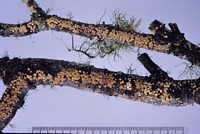
Owner: Herb. PDD | 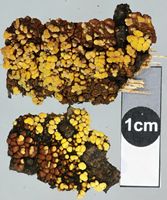
Owner: J.A. Cooper | 
Caption: FIG. 97. Acanthophysium berggreni. Showing portion of a pulvinate fructification
composed of compact hyphae embedding thick-walled gloeocystidia, thin-walled
gloeocystidia, and acanthophyses of the hymenial layer, and allantoid spores. | 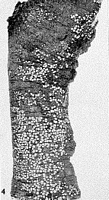
Caption: PLATE I. FIG. 4. Aleurodiscus berggreni, × 1
Showing numerous colonies before becoming coalesced into groups. | 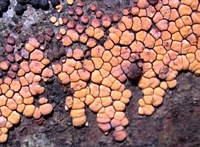
Caption: Aleurodiscus berggrenii
Owner: Nils Hallenberg | 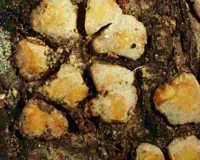
Caption: Aleurodiscus berggrenii, BCP 1854
Owner: B.C. Paulus | 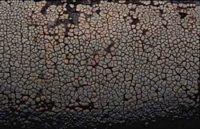
Owner: P.K. Buchanan | 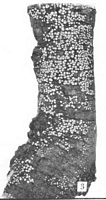
Caption: Pl. 25, fig. 3. Aleurodiscus berggreni. Early stage with scattered pilei. x 1. | 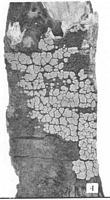
Caption: Pl. 25, fig. 4. Aleurodiscus berggreni. Mature stage with connate pilei. x 1. | 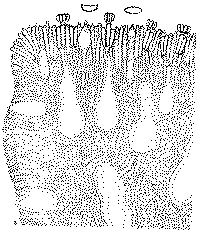
Caption: FIG. 8. Aleurodiscus berggreni. Transverse section showing gloeocystidia and
acanthophyses. Discoloured margin of the pileus on left, x 550; spores, x 1000. |
Article: Cunningham, G.H. (1963). The Thelephoraceae of Australia and New Zealand. New Zealand Department of Scientific and Industrial Research, Bulletin 145: 359 p. Wellington:.
Description: Hymenophore annual, sometimes reviving a second season, coriaceous, fructifications
at first scattered or crowded, discrete, pulvinate, orbicular, attached by a broad base,
0.5-2 mm diameter, becoming confluent in disciform areas 1-1.5 cm across, finally
deeply creviced into irregular polygonal or irregular segments; exterior at first even
and rounded, naked, becoming crenulate; hymenial surface at first convex, pruinose
and even, cream or ochre, at length rugulose or irregular, radiately crenate, finally
deeply creviced and discoloured dingy brown. Context white or isabelline, to 1 mm
thick, composed of densely intertwined, cemented, partly gelatinised hyphae, almost
sclerotioid near the base, embedding massive gloeocystidia and masses of crystals;
generative hyphae to 10 µ
diameter at the base, 4-5 µ in the subhymenium, walls 1-1.5 µ thick, lumena capillary
in context hyphae, with clamp connections. Acanthophyses subclavate, 4-6 µ
diameter, covered on the upper third with closely arranged, blunt pointed spines,
naked below, confined to the hymenial layer. Gloeocystidia abundant, arising in all
parts of the context and hymenium, some penetrating to the surface, 80-160 x 14-18
µ, in the hymenial layer, in the context 30-56 µ diameter with walls 4-8 µ thick,
variable in shape, convoluted and distorted, in the subhymenium fusiform, clavate, or
flexuous-cylindrical. Hymenial layer to 60 µ, thick, a dense palisade of basidia,
paraphyses, acanthophyses, and gloeocystidia. Basidia subclavate, some cylindrical,
20-30 x 5-6 µ, bearing 2-4 spores; sterigmata erect, slender, to 5 µ long. Paraphyses
subclavate, 16-22 x 4-5 µ. Spores allantoid with rounded or acuminate ends,
apiculate, 9-12 x 4-4.5 µ walls smooth, hyaline, 0.2 µ thick, amyloid.
Habitat: HABITAT: Crowded on bark of attached dead branches and dead standing saplings.
Distribution: DISTRIBUTION: New Zealand.
Notes: On examination the type of Hypocrea berggreni in Kew herbarium, ex "Maungatua,
S. Berggren, No. 241" proved to be an Acanthophysium, identical with that later
described as Aleurodiscus peziculoides. The species is endemic to New Zealand and
found on four endemic species of Nothofagus, where it develops upon attached dead
branches or dead standing saplings. At first, fructifications are small, pulvinate,
scattered or crowded, and coloured cream or ochre. Later, between them develop
others which become confluent, forming disciform fructifications with roughened
surfaces, scalloped margins, and discoloured edges. Finally these larger plants become
creviced so deeply that segments separate and persist as individual colonies, in this
stage resembling mature fructifications of Stereum frustulatum, for which species they
have been mistaken by several overseas workers. The older form is often biennial,
reviving a second season. Fructifications then exhibit on the margins discoloured or
black often zoned areas indicating stages of growth. In appearance these two stages
are so diverse that each would be regarded as a different species if collected alone; but
intermediate stages are present in collections listed showing transition from the
pulvinate to the disciform condition. Both are identical in microfeatures.
Context hyphae and acanthophyses are similar to those of certain other species of
Acanthophysium. Hyphae are thick-walled, and densely compacted so that basal
tissues of the context appear sclerotioid, lumena often being capillary. Acanthophyses
are abundant, subclavate, and bear upon the upper third crowded blunt spines. Basidia
are much smaller than those of typical species of the genus, and bear delicate
sterigmata. Gloeocystidia are large, abundant, with unusually thick walls in those
present in the context. Spores are abundant, amyloid, and may be seen embedded in
the hymenial layer as well as lying upon the surface when sections are treated with
Melzer's reagent. When fresh, specimens are scented not unlike sandalwood.
Acanthophysium aberrans, A. apricans, A. australiensis, and A. berggreni form a
small section linked by the clavate acanthophyses.
Article: Wakefield, E.M. (1931). Fungi exotici: XXVII. Kew Bulletin of Miscellaneous Information 1931(4): 201-206.
Notes: In habit the species recalls A. Farlowii Burt and A. Grantii Lloyd. From the former it differs
in the more slender paraphyses, aculeate only at the apex, and from the latter in the
microscopic characters, in so far as they were indicated by the author. The flesh is remarkably
firm for the genus and the elements difficult to distinguish. Scattered throughout the
subhymenial tissue are large globose clusters of mineral matter, reaching up to 30 µ in
diameter.
Article: Cunningham, G.H. (1956). Thelephoraceae of New Zealand. Part XI. The genus Aleurodiscus. Transactions of the Royal Society of New Zealand 84(2): 237-268.
Description: Hymenophore annual, sometimes reviving a second season, coriaceous, pilei at first scattered
or crowded, but discrete, pulvinate, orbicular, attached by a broad base, 0.5-2 mm diameter.
becoming confluent into discoid areas 1-1.5 cm across, finally deeply creviced into irregular
polygonal segments; exterior margin at first even and rounded, naked, becoming crenulate;
hymenial surface at first convex, pruinose and even, cream or ochre, at length rugulose or
irregular, radiately crenate, finally deeply creviced and discoloured dingy brown. Context
white or isabelline, to 1 mm thick, composed of densely woven, cemented, partly gelatinized
hyphae, almost sclerotioid near the base, embedding massive gloeocystidia and masses of
crystals; generative hyphae to 10 µ diameter in the base, 4-5 µ in the hymenial layer, walls 1-1.5 µ thick, lumen capillary in context hyphae, hyaline, branched, with clamp connexions.
Hymenial layer 50-60 µ deep, a dense palisade of basidia, paraphyses, acanthophyses and
gloeocystidia. Basidia subclavate, some cylindrical, projecting slightly, 20-30 x 5-6 µ, 2-4-spored; sterigmata upright, slender, to 5 µ long. Paraphyses subclavate, about the same length
but narrower than the basidia. Acanthophyses subclavate, 4-6 µ diameter, covered on the
upper third with closely arranged bluntly pointed spines, naked below. Gloeocystidia
abundant, arising in all parts of the context and hymenium, some penetrating to the surface,
80-160 x 14-18 µ in the hymenial layer, in the context 30-56 µ diameter with walls 4-8 µ
thick, hyaline, variable in shape, in the sub-hymenium fusiform, clavate, or flexuous-cylindrical, sometimes bearing apically a single gemma, in the context convoluted and
distorted. Spores suballantoid with rounded or acuminate ends, 9-12 x 4-4.5 µ, apiculate,
walls smooth, hyaline, 0.2 µ thick, amyloid.
Habitat: HABITAT. Crowded on bark of attached dead branches and dead standing saplings.
Distribution: TYPE LOCALITY. Maungatua, Otago, New Zealand.
DISTRIBUTION. New Zealand.
Notes: On examination the type of Hypocrea berggreni in Kew herbarium, ex "Maungatua, S.
Berggren, No. 241" proved to be an Aleurodiscus identical with that later described as A.
peziculoides. The species is endemic and confined to four endemic species of Nothofagus,
where it develops upon attached dead branches or dead standing saplings. At first pilei are
small, pulvinate, scattered or crowded, and cream or ochre. This is the stage upon which were
erected Hypocrea berggreni and Aleurodiscus peziculoides. Later, between them develop
other pilei which become confluent, forming large disciform fructifications with roughened
surfaces, scalloped margins and discoloured edges. Finally these larger plants become
creviced deeply, segments separate and persist as separate entities, in this stage resembling
mature fructifications of Stereum frustulosum Fr. In fact they have been so identified by
overseas workers, as was pointed out in a previous paper (Cunningham, 1956). Separately,
these two conditions are so diverse in appearance that each would be regarded as a different
species; but intermediate stages are present in the collections listed showing transition from
the pulvinate to the disciform stage. In microfeatures both are identical, so must be regarded
merely as conditions of growth of one species. The older form is often biennial, reviving a
second season. Pilei then exhibit on the margins discoloured or black often zoned areas
indicating stages of growth.
Context hyphae and acanthophyses are similar to those of certain other species of
Aleurodiscus. Hyphae are thick-walled, densely compacted so that basal tissues of the context
appear sclerotioid, the lumen often being capillary. Acanthophyses are abundant, subclavate
and bear upon the upper third crowded blunt spines. They resemble somewhat those of
Stereum frustulosum. Basidia, on the other hand, are much smaller than those of typical
species of the genus, and bear delicate sterigmata.
Gloeocystidia are large, abundant, with unusually thick walls in those present in the context.
They were mistakenly described as basidia by Miss Wakefield in her account of A.
peziculoides. Spores are abundant, amyloid, and may be seen embedded in the hymenial layer
as well as lying upon the surface when sections are treated with Melzer's reagent. When
fresh, specimens are scented not unlike sandalwood.
A. aberrans and A. berggreni are the only species present in New Zealand in which
acanthophyses are clavate and apically crowned with spines, and spores and basidia are of
relatively small size.
Article: Cooke, M.C. (1879). New Zealand fungi. Grevillea 8(46): 54-68.
Notes: This is certainly an Hypocrea, very similar in character to H. Richardsoni, Berk., although no
fructification or even perfect perithecia could be found. It is very distinct, externally resembling,
at a superficial glance, Diatrype disciforme, in the size and form of the stroma, and habit of
growth.
|